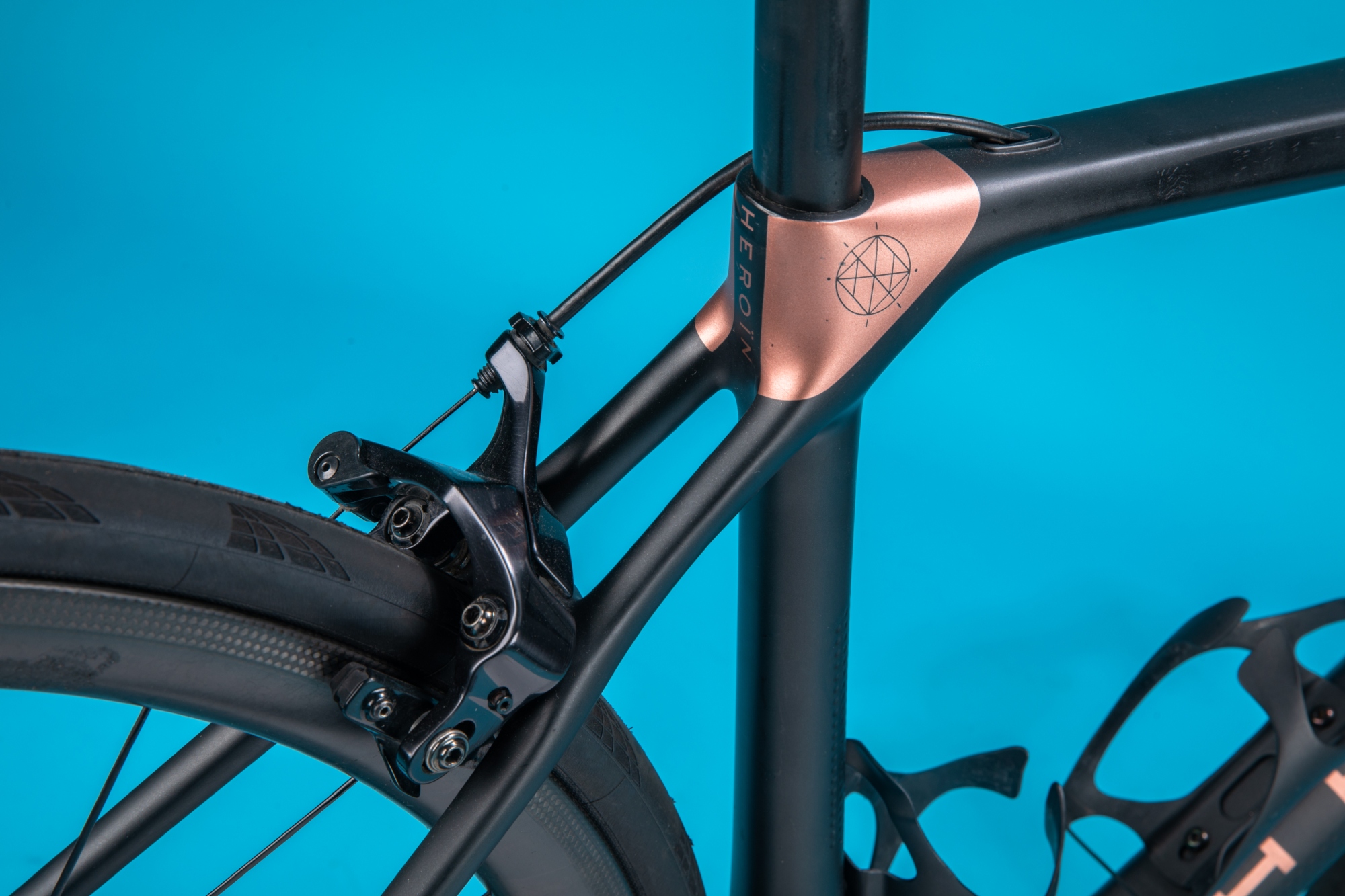Heroïn bike review
The Heroïn bike has been designed for experienced cyclists who want high-end performance for all day rides.

Like any lost love, I’m undecided if I’m grateful for my time with the Heroïn bike, or wished I’d never met it. It’ll be hard to reboot my bike performance baseline after riding something pretty much perfect performance wise.
-
+
Handling
-
+
Performance
-
+
Comfort
- +
-
-
Price
You can trust Cycling Weekly.

It’s been four years since we first heard about the Heroïn bike. Since then it’s all been rather quiet from the almost haute couture brand. In that time it regrouped, re-visited it’s bike offering and is now under the guiding hand of Lee Prescott, Director of VeloAtelier, by appointment bike studio based in Warwick, for its bespoke bike fitting service.
“The team at Heroïn Bikes have spent the last couple of years working on it’s production system” says Lee. “as a result they now have an exceptional carbon build, which I’d put on a par with the likes of Factor bikes, which are as clean on the inside as the external finish”.
>>> Best road bikes 2020: top reviewed bikes for every price point
So what’s changed. In terms of bike geometry and build, other than a disc brake model also now available, not an awful lot.
Bike design
It’s still very much a French based brand, it’s where Heroïn bikes were conceived, by wealthy businessman Marc Simonicini, designed and still assembled. The frame and fork is hand-crafted in Italy at a factory which specialises in aeronautics and motorsports, specifically Formula One and Moto GP.

Tubing profile wise, the Heroïn bike can probably be considered a bit before it’s time, with the square-ish box shapes certainly on par with latest beliefs around aerodynamics for it’s ‘all rounder’ performance classification .
It’s arguably led the concept of it being better to eek out aerodynamic wattage gain from frame and fork tubing shapes, over trying to shed bike weight by carving the slenderest of slender tubes, in trying to make the bike as light as possible, as is the fashion when designing an out and out climbing bike.
The latest race content, interviews, features, reviews and expert buying guides, direct to your inbox!
Cycling Weekly Tech Ed, Michelle, has dived deep into this current phenomenon on her recent reviews of the Specialized S-Works Tarmac SL7 and carried out a handy cross-reference geometry table of equivalent race bikes in her Cannondale Supersix Evo review.
It’s highly recommended click through reading, but in terms of the Heroïn specific comparisons enable you to see that that it’s very much a rouler of a race bike, albeit with a slightly, and I mean teeny tiny, more relaxed head angle, 71° over 71.2°, and slightly, meaning tiny, longer wheelbase, 973mm over 994mm for the equivalent sized Cannondale Supersix Evo.
The stack and reach isn’t 100% exacting, 513.33mm and 375.29mm on the Heroïn bike compared 534mm and 378mm, meaning you’ll be marginally lower for a similar reach than when on the afore mentioned Cannondale.
Crudely put in terms of riding position, the Heroïn is perfect for longer bodies who don’t struggle to get low, but would like nimble, yet desire predictable handling.

The honeycomb, Zipp wheel like, frame tubing remains present on the frame and fork on the Heroïn bike. The brand says that even at speeds as low as 12mph this honeycomb texture improves aerodynamic performance by 10 per cent compared to normal, undimpled, tubing.
The carbon cockpit has also had a revamp. The latest version features a compact shape which fully integrates the rear brake cable, or in the case of the disc version both brake hosing, and control wires with three stem lengths, 90, 110 and 120mm, to choose from.
In the middle, there is now a 27.2 carbon monocoque seat post, which Heroïn say gives greater rider comfort. According to the brand, it has laid the fibre in order to allow for an element of flex, helping to soak up road buzz. The clamping system is hidden inside the frame, which is also where the Di2 battery is stored.
The disc brake Heroïn bike option naturally sees the most in terms of redesigns, for example the vented fork has had to go to take account of the disc brake forces. It would be interested to grab a ride on one and see if there’s any change performance wise.
The ride
I got hold of the size small rim brake version for review and it’s very easy on the eye. Considering it’s still reliant on brake cabling and the Shimano Dura Ace Di2 wiring there’s very little cable on show.
With the only adjustability on the test bike being the saddle height, it took approximately five minutes from delivery to getting out rolling.
Taking a bike with no prior knowledge of brand, or price, for an incredibly hilly ride in the peak district was the closest I’ve ever done to a blind bike test.
Within the first few miles I was already gaining an affinity for the Heroïn bike. I’ve not been physically true race bike bendy for a long while, but the bike’s geo combined with the high modulus carbon frame and fork makes for a very comfortable ride.
Which was a good job, as I was wedded to the bike for approximately seven hours on our first outing for a full day’s Cycling Weekly photoshoot in The Peak District, with no get out clauses for a relationship break.
It was mid umpty-ump turn on a narrow road with an average gradient of 14% (which locals will know as that road that goes from Rainow to the top of Pyms Chair) and where Dan, the photographer, decided shout out “and again” for an hour, when I realised just how brilliant the Heroïn bike was.
By cycling law, I had no right in just hopping on a bike and tackling some of the hardest climbs in the Peaks, before making them harder still by performing 180degree turns on well over 20degree gradients in a four meter tarmac space.
Somehow the Heroïn had gifted me the incredulous bike handling skills of Peter Sagan.
And all of this on a 52/36t chainring with a 11- 28s rear cassette. Ha, it’s enough to make a grown woman laugh, and a grown man (notably her cycling and life companion) cry while out on the next bike ride later that week and the one after that.
Ride after ride the bike keeps on giving. Ok so one would perhaps jokingly expect some form of miracle creation from a bike when it comes with a £9,900 price tag, but I have to be honest and say this isn’t far from it.

I’ve even had the pleasure of swapping out the Continetal Grand Prix 5000 for my new favourite Goodyear Eagle F1 ones, opting for the clincher 28c tyres in tan for the classic bike matchy matchy look.
These, on the DT Swiss PRC 1400 wheels, makes the Heroïn go through something of the bike equivalent of an engine remap - with even more wattage being netted from thin air.
The bike is very surefooted. It’s been thrown both uphill and downhill and it’s delivered every time. Even on the flat Cheshire Plains it’s far from wanting, proving to be the ultimate rouler of a bike.
Value
Performance like this however, doesn't just get handed out. The team behind the Heroïn bike had to do a lot of homework for these gold stars, and that sure is reflected in the price, as, I would argue, it should be.
But like any super high end product, there’s no getting away from the fact that this is a luxury item. Baring a financial windfall of some kind, actual ownership will forever remain a pipedream.
The models do start at £6,800, which is still a heck of a lot of money for most, but what with most training camps cancelled this year, you’d do well to pop the saved money in to a Heroïn bike investment and reap a significantly greater performance gain over what a week in Spain would have every delivered.
Hannah is Cycling Weekly’s longest-serving tech writer, having started with the magazine back in 2011. She has covered all things technical for both print and digital over multiple seasons representing CW at spring Classics, and Grand Tours and all races in between.
Hannah was a successful road and track racer herself, competing in UCI races all over Europe as well as in China, Pakistan and New Zealand.
For fun, she's ridden LEJOG unaided, a lap of Majorca in a day, won a 24-hour mountain bike race and tackled famous mountain passes in the French Alps, Pyrenees, Dolomites and Himalayas.
She lives just outside the Peak District National Park near Manchester UK with her partner, daughter and a small but beautifully formed bike collection.
